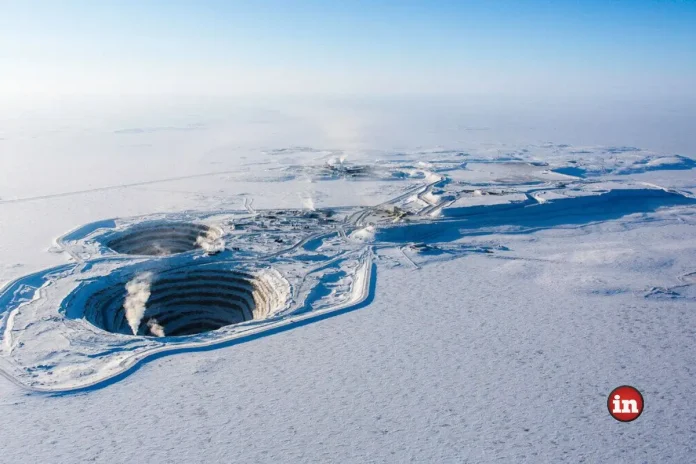The old satellites still circle above the Arctic like tired sentinels, their cameras recording the steady retreat of ice that had stood frozen for millennia. Below them, a new kind of cold war unfolds – one where the temperature rises even as tensions freeze.
In Nuuk, Greenland’s capital, innumerable delegations that have visited in the past year alone – American, Chinese, Russian, European. They come with promises of investment, development, and prosperity. But beneath their diplomatic smiles lies an unmistakable hunger.
As the Earth’s ice sheets melt away, a burning desire rises among the world’s eminent powers to claim the rare earth elements that lie beneath– the same elements that power the smartphone in your pocket and the electric vehicles that crowd our streets. The irony is rich: the same global warming that threatens our very way of life is now making these treasures accessible to the world’s superpowers.
Thousands of miles away, Soviet-era military bases are being reactivated above the Arctic Circle, and they’re not alone. The Americans have reactivated their Second Fleet, and Norwegian military headquarters have crept steadily northward. The Chinese aren’t far behind either, with research stations sprouting up across the region like mushrooms after rain. The tussle for over $30 trillion in resources – larger than the GDP of the United States of America – has only just begun.
The Chinese Dragon roars on
All eyes are on Beijing these days, and of note is the “Polar Silk Road” initiative. It’s documents never mention military strategy or resource extraction. Instead, it speaks of infrastructure development, scientific cooperation, and trade route optimization. The Northwest Passage, now increasingly ice-free, could slash shipping times between Asian factories and European markets by nearly half. Its strategic importance can be seen in China self-designating itself a “Near-Arctic state”, as it seeks to assert its dominance in the region.
Meanwhile, in Brussels, NATO headquarters must be rife with reports of Russian base reactivations and Chinese investments. The old Cold War playbook offers little guidance for this new multi-polar contest. This isn’t about ideology anymore – it’s about controlling the resources that will power the next century of human advancement.
The changing global world order
Each year, the ice retreats further as global warming heats up, melting away the polar ice caps, faster than any model predicted. The permafrost, frozen for thousands of years, now releases ancient methane into the atmosphere, accelerating the warming in a vicious cycle. As mining surveys cut across pristine tundra, and seismic vessels probe the seafloor for oil and gas deposits worth trillions, the sad truth is the symptoms of climate change – and the devastating feedback loops that could destabilize the entire planet’s climate system – are being treated as an economic opportunity.
The stakes are almost incomprehensible. Beneath the Arctic ice and permafrost lies an estimated $30 trillion in untapped resources. Rare earth elements essential for everything from wind turbines to military guidance systems. Oil and gas reserves that could power the global economy for decades. And perhaps most crucially, control over new maritime routes that could reshape global trade.
The competition intensifies with each passing month. Russia reopens and modernizes Soviet-era bases, establishing a military presence that spans the entire Arctic coast. China’s research stations gather crucial data while laying the groundwork for future claims. American submarines patrol beneath the ice, while Canadian rangers increase their presence on the surface.
In corporate boardrooms from Houston to London to Moscow, executives calculate the profits waiting to be unlocked. Mining companies develop new technologies for operating in the harsh Arctic environment. Shipping companies plot routes through waters that were, until recently, permanently frozen. Defense contractors design new weapons systems capable of operating in extreme cold.
But the true cost of this new cold war may be measured not in dollars or rubles or yuan, but in the acceleration of climate change. Each new mining operation, each oil well, each cargo ship breaking through the ice contributes to the very warming that made these activities possible.
The new Cold War intensifies
Back in Nuuk, mining projects are springing anew. The estimated value of the rare earth deposits are enough to transform Greenland from a subsidized Danish territory into one of the world’s wealthiest nations per capita. But at what cost to the environment?
Even as you ponder that, cargo ships already plot new courses through once-frozen waters. Russian bases hum with activity. Chinese researchers collect samples. American submarines glide silently beneath the thinning ice. And the satellites keep watching, recording a transformation that will reshape not just the Arctic, but the global balance of power itself.
The implications stretch far beyond the Arctic Circle. Whoever controls these resources will have unprecedented leverage over global supply chains. Need rare earth elements for your country’s tech industry? You’ll have to deal with whoever controls Greenland’s mines. Want to ship goods from Asia to Europe? You’ll need permission to use the Northwest Passage. Building a green energy infrastructure? The minerals you need lie beneath the Arctic ice.
This new cold war is reshaping more than mere geopolitics; it holds the power and potential to determine the future of human civilization. The decisions made in the next few years will influence not just who controls these crucial resources, but whether their extraction will accelerate us past climate tipping points from which there is no return.
And above it all, the old satellites keep watching, recording the birth of a new global order in the lands of endless night and midnight sun. They bear witness to humanity’s greatest gamble: racing to exploit the resources made accessible by climate change, even as that very exploitation threatens to destabilize the planet’s climate further.
The game plays on, each move bringing us closer to an uncertain future where the winners of this Arctic conquest may find their victory pyrrhic – masters of a rapidly warming world where their triumph means little in the face of accelerating climate chaos.


